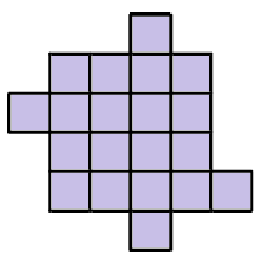Problems
Suppose that a rectangle can be divided into \(13\) equal smaller squares. What could be the side lengths of this rectangle?
Daniel has drawn on a sheet of paper a circle and a dot inside it. Show that he can cut a circle into two parts which can be used to make a circle in which the marked point would be the center.
A square \(4 \times 4\) is called magic if all the numbers from 1 to 16 can be written into its cells in such a way that the sums of numbers in columns, rows and two diagonals are equal to each other. Sixth-grader Edwin began to make a magic square and written the number 1 in certain cell. His younger brother Theo decided to help him and put the numbers \(2\) and \(3\) in the cells adjacent to the number \(1\). Is it possible for Edwin to finish the magic square after such help?
Is it possible to cut such a hole in \(10\times 10 \,\,cm^2\) piece of paper, though which you can step?
Cut a square into \(3\) parts which you can use to construct a triangle with angles less than \(90^{\circ}\) and three different sides.
Can you find a quadrilateral (i.e: a shape with four sides) that can be divided into \(6\) shapes (not necessarily congruent) by using only two straight cuts?
Welcome back! We hope you all had a great summer and now you are ready for the new school year full of fun problems in mathematics. We decided to start with warm-up topic called dissections, so today we will cut various shapes into more elaborate geometric figures in order to reassemble them into a different shape.


